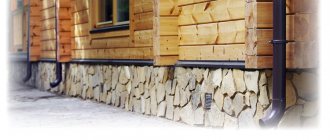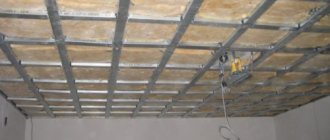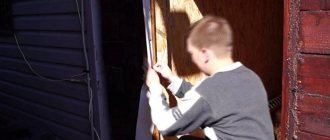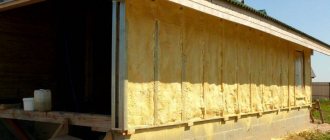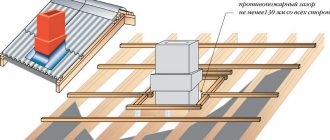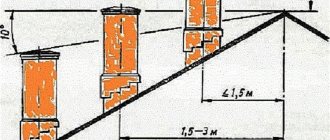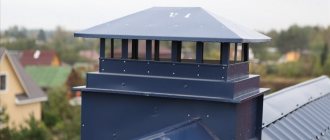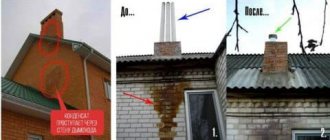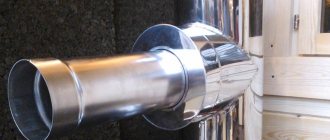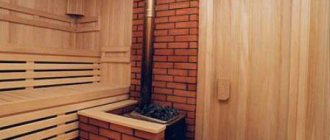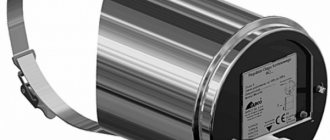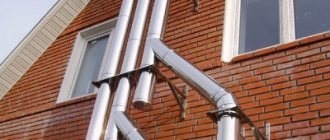Why insulate the chimney pipe from the outside?
Chimneys are made from various materials. It can be either refractory brick or metal, asbestos cement, reinforced concrete.
During operation of heating equipment, a large amount of combustion products and hot air masses move through the smoke channel. All this negatively affects the service life of the chimney, because... Corrosion processes are accelerated and the internal walls of the outlet channel are oxidized. If the pipes are made of metal, then there is also a high probability of a fire if there are errors during operation.
Most often, the chimney is damaged for a number of reasons:
- The presence of moisture in the chimney pipe means increased pressure and constant humidity. Due to the fact that the temperature inside and outside the chimney varies, moisture collects on the walls of the ducts, which negatively affects the condition of the structure.
- Chemical environment - when solid or liquid fuel burns, many aggressive substances appear that are dangerous to human health. If the chimney functions well, without failures, then all the formed substances are removed outside under the influence of natural draft. When the draft decreases and during the inactivity of the smoke exhaust structure, substances begin to accumulate on the walls of the smoke channel, this will lead to the pipe slowly beginning to collapse.
Insulating the chimney from the outside using modern thermal insulation materials significantly reduces the likelihood of damage and reduces the rate of corrosion processes.
Chimney thermal insulation
When planning and constructing a house, most people understand and are well aware of the need for thermal insulation of walls, floors and ceilings.
However, when it comes to the chimney of a stove or fireplace, we are faced with a lot of questions and bewilderment as to why this is necessary.
In this article we will try to talk in detail about why chimney insulation is still necessary, methods of chimney thermal insulation and materials for thermal insulation.
Chimney insulation - why is it necessary?
Chimney repair is a very expensive undertaking. It is for this reason that the chimney is insulated - to prevent possible breakdowns. It has been noticed that an uninsulated chimney of a stove or fireplace quickly loses its physical properties over time and soon breaks.
The reason lies in the formation of condensation, which forms on the internal walls due to unpredictable temperature changes inside and outside the room. For example, in winter, condensation settles on the inner surface of the chimney, penetrates into microcracks in the brick and expands when freezing.
This is how a brick chimney is destroyed.
When wood burns, not only smoke, but also vapors are released into the atmosphere. In addition, by-products are chemicals that are critical to the structure, like acids.
All this partially settles on the chimney, adversely affecting its subsequent performance, namely its throughput.
Subsequently, fireplaces and stoves may begin to smoke, and when the maximum concentration of condensate and sediment is reached, the exit from the chimney may be completely blocked.
Sectional view of chimney insulation option
When a chimney is clogged, excess pressure is created in it, which can damage the entire structure by exploding. This is the main reason for the need for high-quality chimney insulation.
The described negative effects are pronounced in winter, when exposure to high temperature changes occurs. It is possible to extend the service life of a chimney with your own hands, provided that it is insulated with high-quality insulation.
What will insulating a chimney do?
When building a house with a fireplace or stove, as well as when insulating it, be sure to take care of the chimney.
Since it is constantly in contact with the environment, and therefore is exposed to precipitation and temperature changes, there is a huge likelihood of premature destruction.
That is why it is recommended to finish the interior and exterior, which is not difficult and can be done even with your own hands. High-quality thermal insulation of a chimney has the following advantages:
- the service life of the structure increases;
- heat losses are significantly reduced;
- additionally, protection of the roof is guaranteed at the points where it adjoins the pipe;
- the external aesthetic appearance of the pipe is improved.
How to properly insulate a chimney pipe?
For those who want to do the work with their own hands, it is useful to know that today there are several types of special insulation for the chimney of a fireplace or stove. Note that due to the small surface area of the corresponding elements, a minimum amount of materials will be required for their design. Therefore, it is possible to avoid high material costs.
Often, thermal insulation of a chimney occurs with the laying of fibrous insulation: glass or stone mineral wool. In addition, slag concrete slabs and broken bricks can be used for construction. It is recommended to avoid flammable and flammable components due to the constant heating of the inside of the pipe.
No. 1. Chimney installation instructions
Having decided to do everything yourself, you need to approach the choice of materials accordingly so that the work can be completed easily and quickly. If you have instructions from the manufacturer, you must read them carefully; in addition, some materials may be hazardous to the respiratory system, eyes and skin of humans. Personal protective equipment is prepared in advance.
How is an asbestos pipe insulated?
Thermal insulation of a chimney made on the basis of asbestos cement is elementary, for everyone who wants to do it with their own hands. The outside of the structure is finished with mineral wool, but initially it should be wiped from dust and other foreign debris. The insulation is attached using a prepared casing made of galvanized steel, and there should be a technical gap of about 60 mm between it and the pipe.
It will be necessary to make several telescopic elements, placed one on top of the other, with a length of each no more than 150 cm. The insulator is laid sequentially with a tamper along the entire length of the chimney. You can also use bulk thermal insulation materials, for example, broken bricks or technical slag.
A slight slope is created in the upper part, and a cement solution is poured into the resulting voids between the galvanizing and the pipe until the space is completely filled.
Insulation of an asbestos chimney
Some homeowners, doing insulation with their own hands, prefer to do without a casing, and wrap the pipe with several layers of mineral wool, followed by tightening it with clamps. The downside of the presented method is considered to be the non-durability of the structure, since it will definitely absorb moisture, gain mass, “slide” and poorly maintain temperature.
No. 2. Sheathing a brick pipe with tin
How to insulate a steel chimney
In construction stores you can find chimneys ready for use. They consist of stainless steel and insulation. Protective components are resistant to high temperature operating conditions. The pipe is made of two parts with different diameters.
Insulation of a steel chimney
You can make and install a steel chimney yourself. It is enough to place one pipe in another and fix it at a permanent location.
Thermal insulation of steel pipes is carried out by filling the resulting spaces with fibrous insulation or by filling them with building material from the outside.
A standard set of tools may be required, namely a drill, a screwdriver, a tape measure, an angle grinder with a cutting wheel, a knife and mounting tape.
Insulation of a brick chimney
Insulating a conventional stove with a brick chimney, the chimney of a solid fuel or gas boiler with your own hands can be much more difficult than insulating a steel or asbestos one. The choice of insulation must be approached wisely.
Insulation for chimney pipes and its advantages
Dew point of insulated and non-insulated chimney
Many users constantly wonder: is it necessary to insulate the chimney pipe from the outside? Of course, an insulated pipe has a number of positive properties. As already noted, timely thermal insulation of the chimney reduces the negative impact of many factors that negatively affect the material of manufacture. It is very important to choose the correct thickness of chimney insulation. This way you will completely get rid of the problem with condensation, because... the dew point shifts to a section of the pipe that is above the roof level.
In addition, chimney insulation performs a number of important functions:
- Thermal insulation materials do not allow moisture to accumulate on the pipe walls. Due to the same temperature regime of the chimney and combustion products, this prevents condensation from appearing and all harmful substances are removed outside.
- The difference in temperature limits between the hot gases and the smoke duct is reduced.
- Characterized by energy saving. During operation, the insulated chimney absorbs a small amount of energy that is generated during the combustion of fuel. Due to this, the consumption of fuel and energy, which is spent on maintaining a constant temperature regime in the furnace, is reduced.
- The design of the smoke channels becomes more durable.
You can read about stainless steel pipes here.
Types of materials
The material for insulating the chimney pipe of the heating system of private houses is selected based on the type of chimney, its location, as well as the material of its manufacture:
- broken brick;
- plaster;
- mineral wool;
- wooden boards;
- concrete;
- metal cases.
When carrying out insulation, you should strictly follow safety rules. It is very important that the chimney insulation is non-flammable. This is due to the fact that during operation of the heating device the temperature of the insulation will reach up to 100-150° C, and in the area where the pipe exits through the ceilings it can be even higher.
If the work of insulating the pipe will be carried out by one person, then it is better to give preference to a lighter and more solid material. Otherwise, during the insulation process you will have to face a number of difficulties that will negatively affect the final result.
Now let's look at the most popular methods of insulation:
- Plaster is used to insulate chimneys made of brick and stone. The solution is applied to a previously prepared reinforced surface.
- In order to insulate a brick chimney, broken brick is most often used. The material is poured into a casing that is fixed around the chimney. The minimum distance from the chimney is 60 mm. There are cases when slag is used instead of broken brick.
- Chimney insulation with basalt wool above the roof. This material is in great demand; it is produced in the form of mats/cylinders with different internal sections. The material is wrapped near the chimney and attached to steel crimp clamps. The material is inexpensive, but in terms of quality and efficiency it occupies a leading position.
Fireproof insulation
Currently, in private homes, the key element of the heating system is a factory boiler, the chimney of which is made of metal or asbestos cement.
Fire-resistant insulation for a chimney constructed from asbestos cement is carried out by covering the outside of the pipe with materials with high thermal insulation rates. The area that is located above the interfloor ceiling must be thoroughly cleaned of dirt, and then mineral wool must be laid. Afterwards, the entire structure must be placed in a steel casing.
When using non-flammable fireproof material to insulate the chimney, do not forget that the minimum distance between the outer wall of the pipe responsible for the removal of gases and the inner wall of the casing should be 60 mm.
Working with bricks
Brick as a building material is still unrivaled: in brick houses, chimneys are also made of brick. Insulation of a brick chimney can be done in different ways.
Method one
The first method is plastering, which is easy to do with your own hands. A solution of lime and slag is prepared - it is applied to the outside of the brickwork in a layer of 3-4 cm. A layer of plaster will reduce heat loss by 25%. But in order for the plaster to hold up well under the influence of cold and moisture, it should be applied to a mesh.
The sequence of work can be described as follows:
- a reinforced mesh is attached to the brick surface;
- a slag-lime solution is prepared;
- 3-5 layers of plaster are applied to the mesh: the first layer is the most liquid, the subsequent ones are thicker.
Method two
A more effective material for a brick structure is chimney slab insulation.
- the brick pipe is covered with insulation boards (basalt or mineral wool mats);
- the insulation is lined with asbestos-cement slabs or brickwork;
- the structure is plastered.
This method is more complicated, but the efficiency of this design allows you to retain up to 50% of heat.
How to insulate a chimney pipe on a brick street?
Typically, brick chimneys are installed in old houses, which are built according to the type of classical architecture. To insulate such structures, it is best to use plaster.
You need to cover the pipe with several layers of a solution of slag and lime. The total thickness of the layer you will apply must be at least 40 mm. Moreover, it is important that each new layer is thicker than the previous one. When plastering the chimney, all cracks are well coated. Everything that is located above the roof must be covered with a protective layer of oil paint. This way you won’t have to worry about the material being damaged by bad weather.
If you insulate a chimney using this method, you can save up to ¼ of the generated thermal energy.
The second answer to the question of how to insulate a chimney is their location inside the boxes, which are installed around the latter. You can use asbestos-cement slabs, wood or sheet metal, from which the box itself is made. The insulation itself must be laid between the inner walls of the box and the chimney.
The following heat-insulating materials can be used: dry earth, broken glass, brick, mineral wool. By insulating in this way, you can save half of the generated thermal energy.
It is quite difficult to carry out insulation in this way; it is very important to observe all the proportions and execution technique. Therefore, it is better to entrust the work to specialists.
Stages of insulation of a brick chimney
Insulation of a brick chimney is usually carried out either using mesh plastering or using mineral wool. The first method does not make sense to consider, since in most cases it is ineffective (compared to mineral wool).
Using mineral wool, insulation should be carried out according to the following algorithm:
- We clean the surface from any dirt or deposits, check it for unevenness, and eliminate them if found. Since mineral wool is soft, in principle it will lie on uneven surfaces without any problems, so it is not necessary to level the shaft to be perfectly level.
- If you are insulating a chimney that has already been in use, it is recommended to check it outside and inside. You need to make sure that it is not depressurized and does not need repair.
- Mineral wool is attached to the chimney. Since brick chimneys are rectangular or square, rolls are used to insulate them. They are wrapped around the pipe and then secured with screws and/or wire.
- Galvanization is attached on top of the insulation, or finishing is done in any other way to protect the thermal insulation.
How to insulate a metal chimney pipe with your own hands?
In order to insulate a chimney made of metal, a material is used whose design consists of a pair of pipes with different diameters, mounted one inside the other.
Insulation materials such as mineral or balsate wool are placed between the pipes. It is important to choose the correct material thickness. For the inner part of the pipe that runs through the attic, the insulation thickness should be 50 mm, and for the section that is above the roof - 70 mm.
By insulating the pipe in this way, you will solve two problems at once: you will insulate the hood to the required condition, and also protect the structure from accidental fire.
Basalt wool for chimney pipes
How to insulate a coaxial chimney of a gas boiler?
In winter, many owners of private houses have to deal with the problem that the coaxial chimney freezes. In such situations, you have to look for ways to insulate a coaxial chimney.
However, experts advise resorting to another method - reducing the size of the chimney. If the tip freezes due to condensate entering the air intake pipe from a pipe with combustion products, then the length of the inner pipe must be adjusted to the size of the outer one.
It is best to install two separate pipes and insulate them, because... an insulated coaxial structure is unlikely to save the situation.
As you can see, insulating a chimney is not such a difficult task. You just need to select all the materials correctly and follow the work technology.
Let's sum it up
So, when choosing insulation for a chimney, you should pay attention to several factors that will help you decide on the material.
- Chimney type – brick or metal (asbestos pipe).
- Outlet gas temperature.
- Internal or external chimney.
Do not rush into choosing the material and the method of its installation. Watch the video, we are sure it will help consolidate the knowledge of how to insulate a chimney acquired after reading this material.
Many owners of individual houses are interested in how to insulate a metal chimney pipe with their own hands and how to do it correctly. Every experienced handyman knows that for efficient heating of private houses it is necessary to solve a whole range of technical problems. One of them is thermal insulation of smoke exhaust ducts of stoves, fireplaces or gas boilers. It is worth considering in more detail how to increase the resistance of a metal chimney pipe to temperature changes and how to carry out thermal insulation in the Russian climate.
